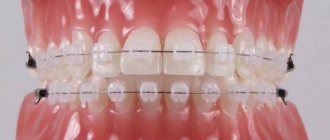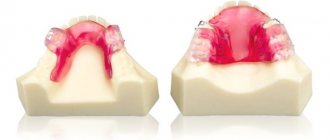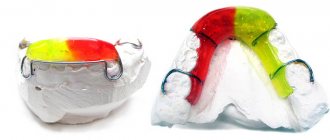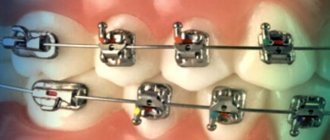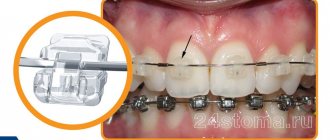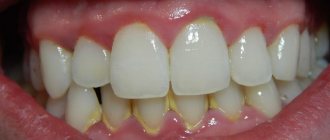The duration of wearing braces frightens many orthodontic patients. Therefore, the most common question that a dentist is asked is how long you need to wear braces to correct your bite. This period will be different for different people. We will tell you in the article what factors determine the maximum and minimum period of wearing braces.
In this article
- What is the bite like?
- Distal bite: how many years do you wear braces to correct it?
- Open bite: how long should you wear braces?
- Mesial bite: how long does it take to correct?
- How long to wear braces for deep bites?
- How long do you wear braces for a crossbite?
- Other factors that affect the length of time you wear braces
- Different braces - how long to wear?
- How long does it take to wear braces depending on age?
- The influence of other factors on the time of bite correction
- Stages of bite correction
- Conclusion
What is the bite like?
Bite (occlusion) is the position of the lower and upper dentition relative to each other when closing. We are talking not only about the position of the teeth, but also the joints and muscles during speech and chewing.
The bite can be normal (physiological), when the teeth close evenly or incorrectly.
How long it will take to correct a bite with braces largely depends on the type of violation of the normal closure of the teeth. The main types of abnormal bite that may require correction with braces include:
- distal;
- open;
- mesial;
- deep;
- cross.
Let's look at each type of bite in more detail. This will help you better understand why in some cases it is necessary to wear braces for a long time.
Distal bite: how many years do you wear braces to correct it?
This type of bite is considered one of the most complex and at the same time common dental anomalies. With this type of closure, the upper teeth protrude noticeably above the lower teeth, and the chin appears small relative to other parts of the face. How strongly the distal bite is expressed can be determined by the “sixes” - the sixth teeth in a row. If, when closing, the upper chewing tooth comes into contact only with the “six” on the lower jaw, this indicates a mild degree of violation. If it comes into contact with two teeth of the lower jaw at once, it is severe. It is easiest to treat distal occlusion in childhood and adolescence, when the jaw continues to form and the teeth are more pliable.
Braces for patients with distal occlusion are most often prescribed as part of complex orthodontic treatment, along with methods that change the shape of the jaw. Thus, adolescents may be prescribed a Frenkel apparatus to correct the upper jaw. To speed up the growth of the lower jaw, the orthodontist may recommend wearing a palatal expander, plate or special trainer.
In adults, the jaw is formed; its position can no longer be changed. But you can use braces to slightly correct the position of your teeth. How long you will have to wear braces to correct a distal bite depends on your age and the severity of the problem. On average, the minimum period of wearing braces for such an anomaly is about 1.5-2 years.
Open bite: how long should you wear braces?
With an open bite, a noticeable gap forms between the teeth. As a rule, it is located in the area of the front teeth and greatly affects the aesthetics of the smile. In addition, with an open bite, the patient may have a lisp, the tongue may fall out of the gap, which reduces the quality of life and affects self-esteem.
It is very difficult to treat open bites on permanent teeth, so the best option is to see an orthodontist in childhood. There are two main methods of treatment - with braces and with surgery. Sometimes doctors combine both methods: first, they correct the position of the teeth using a braces system, and then perform surgery on the jaws. The recommended period for wearing braces to correct an open bite is 2 years or longer.
Installing braces - a perfect smile without pain and problems
Uneven teeth, somehow you need to live with it, communicate with people, smile, create married couples. And if you are a public person, an actor or a politician. Smiling in public a la Dracula will not increase popularity, and such a grin from the page of a glossy magazine will be the reason for many gossips and witticisms. But today this problem is practically absent. Since it is possible to straighten the dentition of both a child and a very young person. An orthodontist's office, everyone can do it here, and your problem, believe me, is not the worst in the field of dentistry. And a perfect smile without pain and problems is worth all the moral and physical costs. The main thing is to make up your mind.
| Indications | Inability to install braces |
|
|
|
|
|
|
|
|
|
|
| |
| |
| |
|
Mesial bite: how long does it take to correct?
With such an anomaly in the closure of the teeth, the lower jaw protrudes forward, and the teeth of the lower row overlap the teeth of the upper one. Mesial occlusion significantly affects facial aesthetics. If the incisors of the two jaws do not meet, this can lead to problems with diction, speech and chewing.
It is impossible to slow down the growth of the lower jaw using dental methods. Therefore, with such a violation, the orthodontist most often decides to stimulate the growth and expansion of the upper jaw. To do this, braces are placed on the first molars and permanent incisors.
How long they are worn depends on various factors. For some, bite correction occurs after 1 year, for another patient it takes 2 years.
The principle of “small forces”, teeth separation and consolidation of treatment results
The essence of orthodontic treatment is to move teeth to the most physiological (natural) position for a particular person.
the most physiological closure of teeth in comparison with three malocclusions
We talk more about the concept of “correct bite” and the causes of dental anomalies in the article How does a malocclusion affect a person’s health, his smile and facial aesthetics?
Do you know exactly how to move teeth so that they take the correct position and do not return to their original place after treatment?
How long to wear braces for deep bites?
A deep bite is a type of abnormal bite in which the upper teeth overlap the lower teeth by more than a third. This disrupts chewing function, contributes to damage to tooth enamel, and can lead to soft tissue trauma. Different treatment methods are suitable for correcting deep bites, depending on the age of the patient and the severity of the disorder.
Children from 6 to 11 years old are most often given plates that correctly guide the growing jaw. In most cases, braces are used to correct deep bites in adolescents and adults. Braces are worn for deep bites for an average of one and a half years.
In difficult cases, orthodontic treatment is not enough and the patient may require surgery.
Indications
Uneven teeth occur in children and adults. They confuse ordinary people, but celebrities who speak in public and act in films and glossy magazines suffer even more. Fortunately, correcting your teeth is no longer a problem. The orthodontist's office will make it perfect. The most effective and currently popular correction method is the installation of braces.
Clear indications for installing braces are:
- severe and unusual malocclusions;
- age over 12 years;
- the patient has full legal capacity, good mental health;
- consent to the procedures, with an understanding of their nature.
Other factors that affect the length of time you wear braces
The type of bite and the severity of the orthodontic defect are not the only factors that determine how long to wear braces. The following points also affect the timing:
- type of orthodontic structure;
- patient's age;
- individual characteristics of the body of a particular patient;
- quality of hygienic care for braces.
Different braces - how long to wear?
Modern dentistry offers a huge selection of brace systems of various designs, made from different materials, with varying strength and aesthetic properties. All of these factors can affect the length of time you wear braces.
- Metal braces.
This system is considered the most durable and puts maximum pressure on the teeth. The main disadvantage is that these braces are noticeable to others and affect your appearance. On average, they are worn from one to one and a half years.
- Ceramic braces.
They look aesthetically pleasing, invisible to others, and have good strength. But they do not put as much pressure on the teeth as metal ones. Therefore, the period of wearing such braces is usually several months longer. On average it ranges from one to three years.
- Sapphire designs.
The characteristics are similar to ceramic ones; they are also worn for 1-3 years. But sapphire braces require especially careful care.
- Lingual braces.
They are installed on the inside of the teeth, which makes these braces invisible. The disadvantage is that when wearing them, a person may experience discomfort in the mucous membrane or tongue. On average, lingual appliances are worn for 1.5 to 2.5 years.
Advantages and disadvantages of caps
They are invisible to others. This is a fundamental criterion for patients whose work requires an impeccable appearance. When you need an inconspicuous structure on your teeth, it is better to install mouth guards. They do not scratch the gums and tongue and do not affect diction. They have a comprehensive effect on the dentition, covering all crowns. They are easy to wash simply under running water or using rinse aid. In addition, patients do not develop caries and the enamel is not damaged.
Among the disadvantages is the high price. It takes a month to make the trays. Sometimes patients forget to put on a mouthguard after eating or hygiene. In this case, the effectiveness of treatment decreases. There is a risk of damage to the record.
How long does it take to wear braces depending on age?
To understand how long to wear braces, you need to take into account the age of the patient. Modern dental technologies make it possible to correct the bite at any age, but the duration of treatment increases in direct proportion to the number of years. A problem that can be corrected in a child in six months will take several years for a mature person to correct. The best age for installing braces is considered to be adolescence - from 12 to 17 years. At this time, malocclusions are corrected as quickly and easily as possible, which can be explained by physiological characteristics:
- Although the dental system in adolescents is already fully formed, it remains quite mobile and “flexible” for some time, therefore, with the help of proper orthodontic treatment, it is possible to move teeth and change the position and shape of the jaw bones.
- During adolescence, muscles and ligaments, which also play an important role in occlusion, remain highly mobile.
Typically, braces are placed on teenagers after the second molars have erupted and when the baby teeth are completely replaced by permanent teeth. At a young age, bone tissue, due to its elasticity, quickly responds to mechanical stress. Therefore, teenagers are usually given braces for a year and a half. This time is enough to correct existing malocclusions.
After 24-25 years, metabolism slows down, bones stop growing and developing, tissues lose elasticity. It takes much longer for the teeth and jaw to change their incorrect position under the pressure of braces. Dentists say that the time required for bite correction in adults approximately doubles compared to adolescence. That is, on average you will have to wear braces for 2-3 years. But the exact time is determined by the doctor, based on the goals of a particular patient (aesthetics or functionality), individual characteristics of the jaw structure and other factors.
The principle of "small forces"
At the dawn of the development of orthodontics, doctors did not stand on ceremony with crooked teeth. Such teeth were removed, or they were pressed on with fingers and rotated with forceps, trying to move them to the desired position. But over the years of experiments and scientific research, it has been found that the most effective way to move teeth is the constant impact of “small forces.”
moving teeth using the principle of “small forces”
Why should the impact on moving teeth be constant, but not too strong?
The displacement of teeth and their fixation in a “new place” is achieved due to the resorption of bone tissue on one side of the tooth and the formation of new bone on the other side. It takes time to move teeth without harm. The speed of tooth movement is on average 0.3-0.8 mm per month. Therefore, the treatment time for braces and aligners is approximately the same.
The influence of other factors on the time of bite correction
Each person's bone tissue, muscles, and joints react differently to the effects of braces. For some, the correction process occurs faster, for others slower. Much depends on the quality of hygienic care for the brace system, on the health of the teeth and oral cavity, and on compliance with the rules of operation of the orthodontic structure.
If a patient violates the doctor’s recommendations, does not brush his teeth thoroughly enough, or does not use special devices for cleaning braces, this can lead to the development of caries and other dental diseases. They require treatment and tend to slow down the orthodontic correction process.
If the braces break due to careless handling or need to be removed for dental treatment, this will disrupt the process of correcting the bite. The longer a person goes without braces (and making a new system to replace a broken one takes time), the stronger the regression. The teeth may return to their original position, and then treatment will need to be started all over again. Accordingly, the period of wearing braces will be reset to zero.
More about bans
Caries, periodontal disease, gingivitis, bleeding gums and a number of other diseases are contraindications for installing braces. First of all, these ailments are treated, and only then can we talk about braces.
In the case of osteoporosis, when bone tissue gradually turns into dust, braces can and most likely will destroy the spongy jaw substance, thereby causing massive tooth loss. Diseases of the immune system cause sensitivity to any microorganisms, etc.
Important: And therefore it is the sacred duty of the physician to carefully check the potential client for the presence or absence of the specified diseases and inform him of the consequences. The client himself must treat the prohibition with understanding, since it is his health and there is no need to improvise with it. Installing braces is convenient, beautiful, and not expensive. The main thing is no fantasy.
Stages of bite correction
When talking about the minimum or maximum period of bite correction with braces, we must take into account the fact that orthodontic treatment takes place in several stages. Before installing braces, careful preparation is required; after removing them, it is important to consolidate the result. Therefore, the actual period of bite correction is always longer than the actual period of wearing the braces. Let's tell you more about the stages of bite correction.
- Preparatory stage.
The stage includes treatment of caries, periodontal diseases, strengthening of tooth enamel, as well as professional teeth cleaning using ultrasound or other modern methods. Also at the preparatory stage, a full range of diagnostic examinations and an assessment of the physiological and anatomical characteristics of the patient are carried out. This stage can take from several days to several weeks, depending on the condition of the oral cavity and other factors. Based on the results of the preparatory stage, the dentist determines the optimal treatment regimen and selects an orthodontic design.
- Installation of bracket system.
This is the fastest stage, taking from 1.5 to 2 hours.
- Bite correction with braces.
The leveling period consists of crooked teeth aligning straight along an arc. This usually takes 4-8 months. Next, the doctor places rigid arches that promote mechanical movement of the teeth forward or backward and help close large gaps between the teeth. This period takes from six months to one and a half years. During the final period of wearing the braces system, the contacts between the teeth are compacted, they occupy the most correct position in the dentition. The final period of treatment lasts from two months to six months.
- Retention stage.
After removing braces, there is a risk that the teeth will return to their previous position. To avoid this, the dentist prescribes the patient to wear retainers. These are devices that hold teeth in the desired position and help consolidate the result. The retention period usually lasts twice as long as wearing braces.
How does a metal arch move teeth?
When talking about braces, we have repeatedly mentioned the “metal arch,” which apparently is an important element in moving teeth. But do you know why she moves her teeth?
metal arc with “memory effect”
At the end of the 20th century, the National Space Agency (NASA) developed an alloy of nickel and titanium materials that could “remember its shape” and return to its shape at a certain temperature. When planning treatment, the orthodontist determines the position that the teeth should ultimately occupy and “programs” this movement by giving the metal arch the desired shape.
When the archwire is attached to the teeth and heated in the mouth, it tends to the “programmed” shape and moves the teeth into the desired position.
This is how braces systems work, and now let’s figure out how aligners—transparent orthodontic aligners—work.
